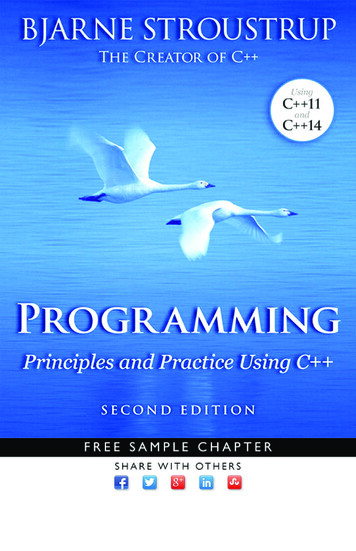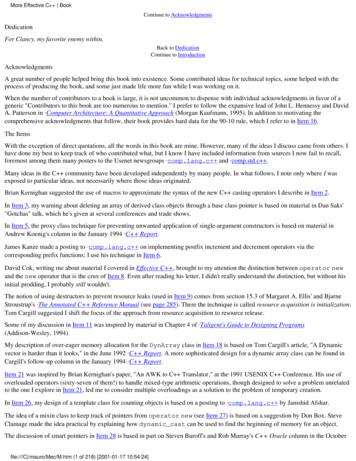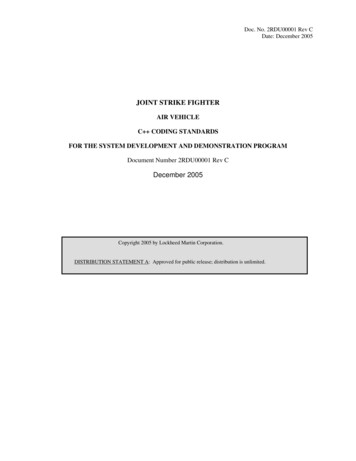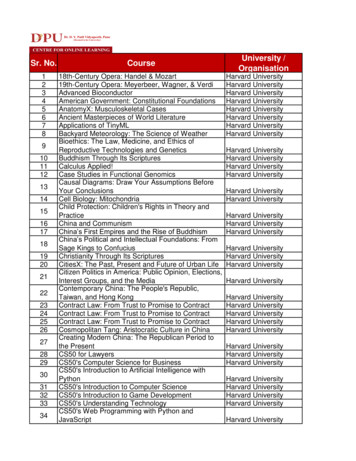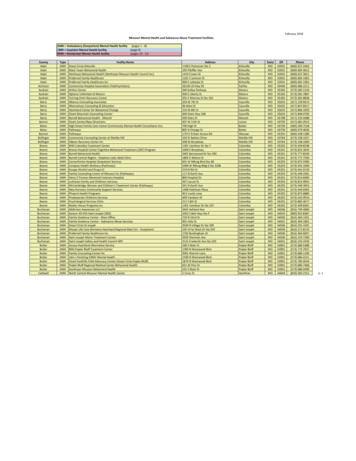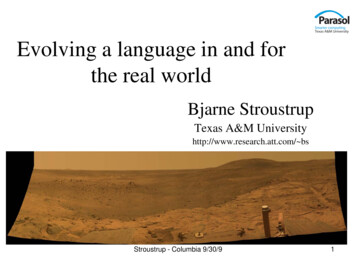
Transcription
Evolving a language in and forthe real worldBjarne StroustrupTexas A&M Universityhttp://www.research.att.com/ bsStroustrup - Columbia 9/30/91
Overview 1951-1978: Prehistory – Aims and Ideals1979-1990: The early years – C with Classes and C 1991-1997: Explosive growth – STL and C 981998-2008: Living in the real world – C 0xStroustrup - Columbia 9/30/93
8000 Programming Languages C ’s family tree (part of)AssemblerAda95AdaObject PascalPascalC89/99FortranAlgolBCPLCC 0xC SimulaC#MLLispSmalltalkJava And this is a gross oversimplification!Stroustrup - Columbia 9/30/94
Programming languages A programming language exists to help people express ideas– Programming language features exist to serve design and programmingtechniques– The real measure of value is the number, novelty, and quality ofapplicationsStroustrup - Columbia 9/30/95
Assembler –1951 Machine code to assembler and ocumentationStroustrup - Columbia 9/30/96
Fortran –1956 A notation fit for humans– For a specific application domain A(I) B(I) C*D(I)– Efficiency a premium– PortabilityStroustrup - Columbia 9/30/97
Simula –1967 Organize code to model “the real world”– Object-oriented design Let the users define their own types (classes)– In general: concepts map to classes– “Data abstraction” Organize classes into hierarchies– Object-oriented programmingStroustrup - Columbia 9/30/98
C –1974 An simple and general notation for systems programming– Somewhat portable– Direct mapping of objects and basic operations to machine Performance becomes somewhat portableStroustrup - Columbia 9/30/99
C with Classes –1980 General abstraction mechanisms to cope with complexity– From Simula General close-to-hardware machine model for efficiency– From C– Became C in 1984– Commercial release 1985Stroustrup - Columbia 9/30/910
ISO Standard C C is a general-purpose programming language with abias towards systems programming that––––is a better Csupports data abstractionsupports object-oriented programmingsupports generic programmingFrom day 1 (1980)From mid-1983From about 1994 A multi-paradigm programming language– The most effective styles use a combination of techniquesStroustrup - Columbia 9/30/911
C applications(www.research.att.com/ bs/applications.html) TelecommunicationsGoogle, Amazon, Microsoft applications and GUIsLinux tools and GUIsFinancialGamesPhotoShopMost browsers Mars RoversMarine diesel enginesCell phonesHuman genome projectHigh-energy physicsMicro electronics design and manufacturing Stroustrup - Columbia 9/30/912
What’s distinctive about C ? Stability– Essential for real-world software– 1985-2008– 1978-2008 (C and C with Classes) Non-proprietary– Yet almost universally supported– ISO standard from 1998 Direct interface to other languages– Notably C, assembler, Fortran Abstraction machine model– Zero overhead principle For basic operations (e.g. memory access) and abstraction mechanisms– User-defined types receive the same support as built-in types– Standard library written in the language itself And most non-standard librariesStroustrup - Columbia 9/30/913
Aims for C Support real-world software developers– “better software now”– by “better” I mean correct, maintainable, efficient, portable, Change the way people think about software––––Object-oriented programmingGeneric programmingResource managementError handling Functional, not academic, beauty– “even I could have designed amuch prettier language” – B.S. 1984 or soStroustrup - Columbia 9/30/914
Ideals The fundamental ideals for good design– Represent ideas directly in code– Represent independent ideas independently in code– Represent relationships among ideas directly in code Hierarchical Parametric– Combine ideas expressed in code freely where and only where combinations make sense C – Make these ideals viable for the largest possible range of application areas “viable” includes “affordable” and “on available hardware” “viable” includes “performs as well as the gold standard in a given area”– e.g. Fortran for scientific computation and C for systems programming “viable” includes “in the hands of ordinary programmers”Stroustrup - Columbia 9/30/915
Language features – 1979-1990 C with Classes (1979-84)–––––––Function argument declarations and checkingconst (also in constant expressions)ClassesDerived classesConstructors, destructorsnew and deleteInline functionsNot in C untilmuch laterHuge impact C (in 1983-86)– Overloading (incl. , [], and ())– virtual functions– Type-safe linkage C (1988-90)– Templates– ExceptionsRather lateStroustrup - Columbia 9/30/916
Basic resource management A resource can be memory, file handle, lock, socket, etc.class vector {vector(int s); // constructor: validate arguments, acquire resources vector();// destructor: release resources// };void f(int s){vector v(s);// }Stroustrup - Columbia 9/30/917
Object-oriented programming Class hierarchies, dynamic lookup, and static interfacesclass Shape {Point c; // common implementation detail: often a dumb ideaColor col;public:// common user interfacevirtual void draw();virtual void move(Point p) { c p; }virtual void rotate(int deg);// };class Circle : public Shape {Circle(Point cc, Color co);void rotate(int) {} // nice optimal algorithm// Stroustrup - Columbia 9/30/9};18
C ISO Standardization – Membership About 22 nations(8 to 12 at a meeting)– ANSI (US national committee)hosts the technical meetings– Other nations have furthertechnical meetings Membership have varied– 100 to 200 200 members currently– 40 to 100 at a meeting 60 currently Most members work in industry Most are volunteers– Even many of the company representatives Most major platform, compiler, and library vendors are represented– E.g., IBM, Intel, Microsoft, Sun End users are underrepresentedStroustrup - Columbia 9/30/919
C ISO Standardization – ProcessFormal, slow, bureaucratic, and democratic– “the worst way, except for all the rest”(apologies to W. Churchill)Most technical work happens– in “working groups”– electronically between meetingsStroustrup - Columbia 9/30/920
For C , the ISO standards process is central Standard support needed for mainstream use– Huge potential for improvement of application code– For (far too) many “if it isn’t in the standard it doesn’t exist” Significant defense against vendor lock-in C has no rich owner– who can dictate changes, pay for design, implementation, marketing, etc. The C standards committee is the central forum of the C community– Endless discussions among people who would never meet otherwise The committee receives feedback from a broad section of the community– Much of it industrial The committee is somewhat proactive– Adds features not previously available in the C worldStroustrup - Columbia 9/30/921
C ISO Standardization – Results1998 ISO standard– 22-0 vote2003 Technical Corrigenda– “bug fix release”; no new features2008 Registration draft for C 0x– 2011? Technical reports–––––Library (2004)Performance (2004)Decimal floating point (2008)Library2ModularityStroustrup - Columbia 9/30/922
Language features: 1991-19981992199319941996Covariant return typesRun-time type identification (RTTI: dynamic cast, typeid, and type info)Declarations in conditionsOverloading based on enumerationsnamespacesmutableNew casts (static cast, reinterpret cast, and const cast)A Boolean type (bool)Explicit template instantiationExplicit template argument specification in function template callsMember templates (“nested templates”)Class templates as template argumentsIn-class member initializersThe sum is farSeparate compilation of templates (export)more significantTemplate partial specializationthan the partsPartial ordering of overloaded function templatesStroustrup - Columbia 9/30/923
C 98 example: Resource management Standard library containers– with exception-safety guarantees(e.g., vector)– the techniques can be used byevery user No resources are leaked– E.g. vector elements and filehandles (handled by ifstream)– Destructors do cleanup guaranteed, implicitly– Based on a simple and systematicview of resource managementvoid f(string s){vector int v;ifstream is(s);// int x;while (is x) {if (x 0) throw Bad value(x);v.push back(x);}// } Resources: e.g. locks, sockets,memory, thread handles, filehandles Exception safety guaranteesStroustrup - Columbia 9/30/9 RAII24
The STL Ideal: The most general and most efficientexpression of an algorithm– Focus on algorithms– Separate algorithms from data Using iterators– Go from the concrete to the abstract Not the other way– Use compile-time resolution to eliminate overheads Inlining and overloading– Where needed, parameterize with policies E.g. sorting criteriaStroustrup - Columbia 9/30/925
STL example: find if Definitiontemplate class Iter, class Pred Iter find if(Iter first, Iter last, Pred p){while (first! last && !p(*first)) // while not at end and predicate not met first;// advance to next elementreturn first; // return the element reached}pi find if(v.begin(), v.end(), Less than int (42));if (pi! v.end()) {// found it!}Stroustrup - Columbia 9/30/926
C 0x: 2002-2008 Overall goals– Make C a better language for systems programming for library building– Make C easier to teach and learn generalization better libraries Massive pressure for– More language features– Stability / compatibility Incl. C compatibility Insufficient pressure for– More standard libraries The committee doesn’t have the resources required for massive librarydevelopmentStroustrup - Columbia 9/30/927
C 0x: Areas of change Machine model and concurrency––––Memory modelThreads library, asynchronous returnAtomic APIThread-local storage Support for generic programming– auto, decltype, template aliases, Rvalue references, – General and uniform initialization– Lambdas Etc.– improved enums– long long, C99 character types, etc.– Libraries– Regular expressions– Hashed containers– Stroustrup - Columbia 9/30/928
C 0x: language features decltype and auto — type deduction from expressionsTemplate aliasesMove semantics (rvalue references)Static assertions (static assert)long long and many other C99 features (without a space) to terminate two template specializationsUnicode data typesVariadic templatesGeneralized constant expressions (constexpr)Generalized initializer listsScoped and strongly typed enumerations (class enum)Control of alignmentnullptr — Null pointer constantA for-statement for rangesDelegating and forwarding constructorsThe whole is muchThread-local storage (thread local)more than its partsDefaulting and inhibiting common operationsLambda expressions Stroustrup - Columbia 9/30/929
Performance and conveniencetemplate class C, class V vector typename C::iterator find v(C& s, V v)// find all occurrences of v in s{vector C::iterator res;for (auto p s.begin(); p! s.end(); p)if (*p v) res.push back(p);return res;}vector string m { "Dennis", "Joe", "Brian", "Al", "Joe", "Bill" };for (auto x : find v(m,"Bill"))if (x! "Bill") cerr "bug!\n";Stroustrup - Columbia 9/30/930
Why did C succeed? Reasons– Low-level access plus abstraction mechanisms Performance Direct access to real hardware Very general zero-overhead abstraction––––––C compatibilityA useful tool (from day #1)TimingNon-proprietary – ISO standardStableEvolving“Being best at one or two things is not enough, you must be good enoughat everything someone consider important”Stroustrup - Columbia 9/30/931
Why did C succeed? Popular non-reasons– Just luck For 25 years!– AT&T’s marketing might Must be a joke – It was first Except for Ada, CommonLoops, Smalltalk, Eiffel,Objective C, Modula-2, C, Fortran, ML, – Just C compatibility Never 100%– It was cheapest Not for most of its lifetime (incl. all the early years)Stroustrup - Columbia 9/30/932
Templatemeta-programming!What is C ?A hybridlanguageA ’s C!Embedded systemsprogramming languageToo big!An object-orientedprogramminglanguageSupportsgeneric programmingLow level!Stroustrup - Columbia 9/30/9A randomcollection offeatures33
C A language forbuildingsoftwareinfrastructuresand resourceconstrainedapplicationsA light-weight-abstractionprogramming languageStroustrup - Columbia 9/30/934
Thanks! C and Simula––––– ISO C standards committee–––––– Brian KernighanDoug McIlroyKristen NygaardDennis Ritchie Steve ClamageFrancis GlassborowAndrew KoenigTom PlumHerb Sutter C compiler, tools, and library builders– Beman Dawes– David Vandevoorde– Application buildersStroustrup - Columbia 9/30/935
More information My HOPL-II and HOPL-III papers The Design and Evolution of C (Addison Wesley 1994) My home pages– Papers, FAQs, libraries, applications, compilers, Search for “Bjarne” or “Stroustrup” The ISO C standard committee’s site:– All documents from 1994 onwards Search for “WG21” The Computer History Museum– Software preservation project’s C pages Early compilers and documentation, etc.– http://www.softwarepreservation.org/projects/c plus plus/– Search for “C Historical Sources Archive”Stroustrup - Columbia 9/30/936
C/C compatibility A constant sore point– Separate standards committees A tragedy– Constant borrowing Both ways Often incompatibly– Widely demanded by users Rightfully so– Widely despised by users “Against OO” “Against the spirit of C”Stroustrup - Columbia 9/30/937
Java. C 0x Pascal Ada Ada95. Object Pascal. ML. BCPL. C89/99 And this is a gross oversimplification! . - Direct mapping of objects and basic operations to machine Performance becomes somewhat portable. Stroustrup - Columbia 9/30/9 10 . Too big! Supports generic programming. Stroustrup - Columbia 9/30/9 33. C A language for .


